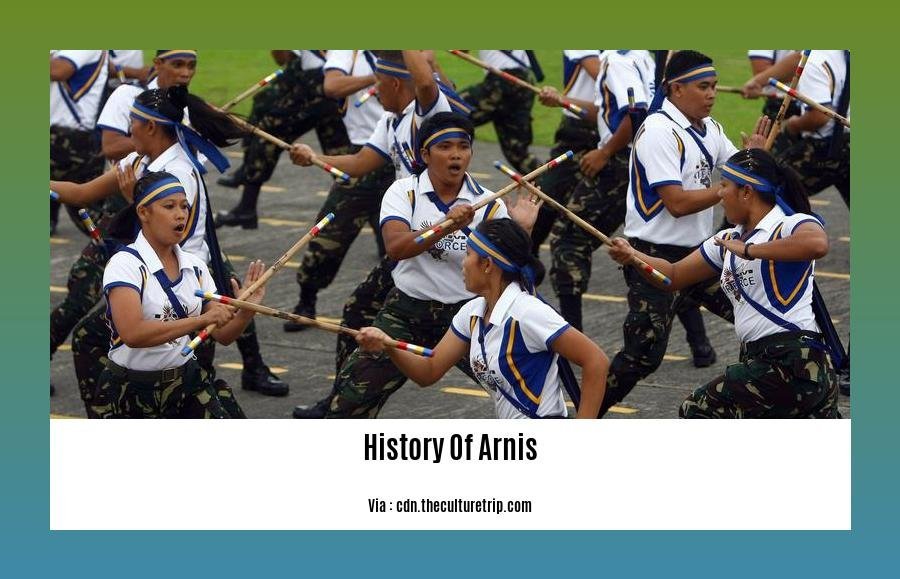Unveiling the History of Arnis: A Journey Through Time. Embark on a captivating exploration of Arnis’s rich history, where we unravel the origins, evolution, and cultural significance of this remarkable martial art. Delve into historical accounts and discover the timeline that shaped its development, from its humble beginnings to its global recognition.
Key Takeaways:
- Arnis is a Filipino martial art utilizing sticks, knives, and weapons.
- It originated from “kali,” meaning “long blade” in Malayan.
- Arnis was banned by Spanish colonizers but continued secretly.
- Arnis re-emerged in the 20th century as a cultural heritage.
- Remy Presas introduced Arnis to education and the world as “Modern Arnis” in 1969.
- Arnis was declared the national sport and martial art of the Philippines in 2009.
History of Arnis

Unraveling the rich tapestry of Arnis’s past is a fascinating journey that takes us through centuries of cultural evolution and martial prowess.
Origin and Etymology
Arnis traces its roots back to the Malayan word “kali,” denoting a long blade. This ancient weapon-based art was prevalent in Southeast Asia, including the Philippines.
Spanish Colonialism and Suppression
When the Spanish colonizers arrived in the Philippines, they sought to suppress indigenous practices, including native martial arts. Arnis was banned, forcing Filipinos to practice it in secret.
Resurgence and National Identity
In the 20th century, Arnis resurfaced as a symbol of national heritage and cultural identity. Remy Presas played a pivotal role in its revival, introducing it into the Philippine education system in 1969 and later popularizing it globally as modern arnis.
Recognition and Legacy
In 2009, Arnis was officially declared the national sport and martial art of the Philippines. This recognition underscored its deep cultural significance and enduring legacy as a treasured tradition.
If you want to know further about how this martial art form came about, check out our page about the History Of Arnis Kali And Eskrima.
If you are looking for a simplified and an easy-to-understand version of the history of Arnis, you might want to check out our History Of Arnis Brainly page.
For those of you who are interested to know about the History Of Arniston, go and check our dedicated page about it.
Origins

Unraveling the intricate tapestry of Arnis unveils a rich history interwoven with cultural heritage and resilience. Its origins can be traced back to the indigenous martial art of the Philippines.
The seeds of Arnis were sown in the Visayan and Luzon islands during the Spanish colonial era. To circumvent a weapons ban imposed by the colonizers, Filipino warriors ingeniously disguised their martial art as folk dance, using wooden sticks in lieu of steel blades.
Echoes of Arnis’ origins can be found in traditional Moro-moro stage plays, where mock battles with wooden swords symbolized the clash between Christian and Muslim forces. These performances provided a covert space for Filipinos to practice their martial art.
Etymology:
The name “Arnis” is derived from the Old Spanish word “arnés,” meaning “armor.” This term was inspired by the armor costumes used in Moro-moro plays, which concealed the true nature of the martial art being practiced.
Key Takeaways:
- Filipino warriors developed Arnis to circumvent a weapons ban imposed by Spanish colonizers.
- Arnis was disguised as folk dance to avoid detection.
- The name “Arnis” comes from the Old Spanish word “arnés,” meaning “armor.”
Sources:
History Of Arnis Timeline
Arnis, an intricately woven tapestry of Filipino martial heritage, has left an enduring imprint on the annals of time. Its saga unfolds as a captivating symphony of resilience, innovation, and cultural preservation. Let’s traverse the milestones that have shaped its remarkable journey.
Pre-Colonial Era (900 AD):
- The genesis of Arnis lies in pre-Hispanic Filipino civilizations, with its roots in the indigenous combat techniques employed by tribes and kingdoms.
Spanish Era (1521-1898):
- Spanish colonizers sought to quell resistance by prohibiting indigenous weapons, including those used in Arnis.
- Despite the ban, Filipinos ingeniously disguised their practice, incorporating Arnis into folk dances and stage plays.
American Era (1898-1946):
- The American occupation brought a resurgence of Arnis, as it was no longer suppressed.
- Filipino martial arts enthusiasts began to systemize and codify Arnis techniques.
Post-World War II (1946):
- Remy Presas, a renowned Arnis master, played a pivotal role in popularizing Arnis.
- Presas introduced Arnis to the Philippine education system and later founded the Modern Arnis system.
Contemporary Era (1969-Present):
- In 2009, Arnis was declared the national sport and martial art of the Philippines.
- Today, Arnis continues to flourish, with practitioners worldwide embracing its rich traditions and evolving techniques.
Key Takeaways:
- Arnis originated in pre-colonial Philippines as a combat system.
- Spanish colonization prompted Filipinos to conceal Arnis within cultural practices.
- Arnis experienced a revival during the American era and gained international recognition post-WWII.
- Modern Arnis systems, such as those developed by Remy Presas, contributed to its widespread popularity.
Citations:
- History – Arnis Philippines
- Arnis History – The Grand History of Filipino Martial Arts
FAQ
Q1: What is the origin of Arnis?
A1: Arnis originated from native Filipinos in Luzon and the Visayas during the Spanish colonial era as a means of circumventing a weapons ban imposed by the Spaniards.
Q2: How did Arnis survive during the Spanish colonial era?
A2: Filipinos disguised Arnis as folk dance, incorporating mock battles with wooden swords inspired by armour costumes used in traditional Moro-moro stage plays.
Q3: When did Arnis resurface as a national heritage?
A3: Arnis resurfaced in the 20th century as a national and cultural heritage, gaining recognition and popularity.
Q4: Who introduced modern Arnis?
A4: Remy Presas introduced modern Arnis to the Philippine education system in 1969 and later to the world.
Q5: When was Arnis declared the national sport and martial art of the Philippines?
A5: Arnis was declared the national sport and martial art of the Philippines in 2009.
- Unlock Water’s Symbolism: A Cross-Cultural Exploration - April 20, 2025
- Identify Black and White Snakes: Venomous or Harmless? - April 20, 2025
- Unlocking Potential: Origins High School’s NYC Story - April 20, 2025



![- Unraveling the History of Arnis: A Filipino Martial Art Legacy [History Of Arnis Brainly] History-Of-Arnis-Brainly_2](https://www.lolaapp.com/wp-content/uploads/2024/02/History-Of-Arnis-Brainly_2-150x150.jpg)











